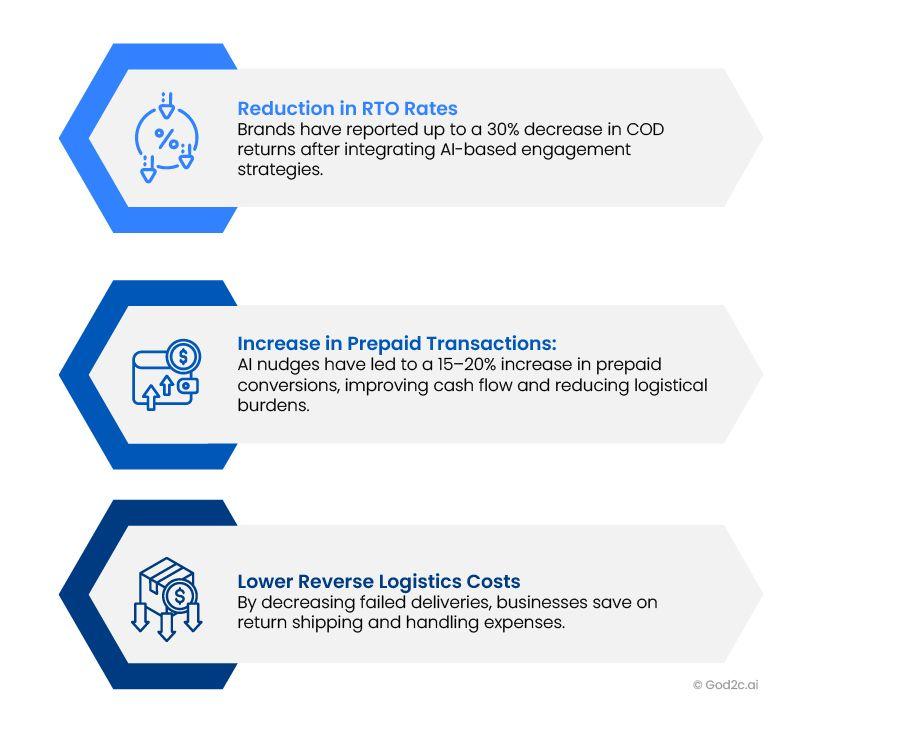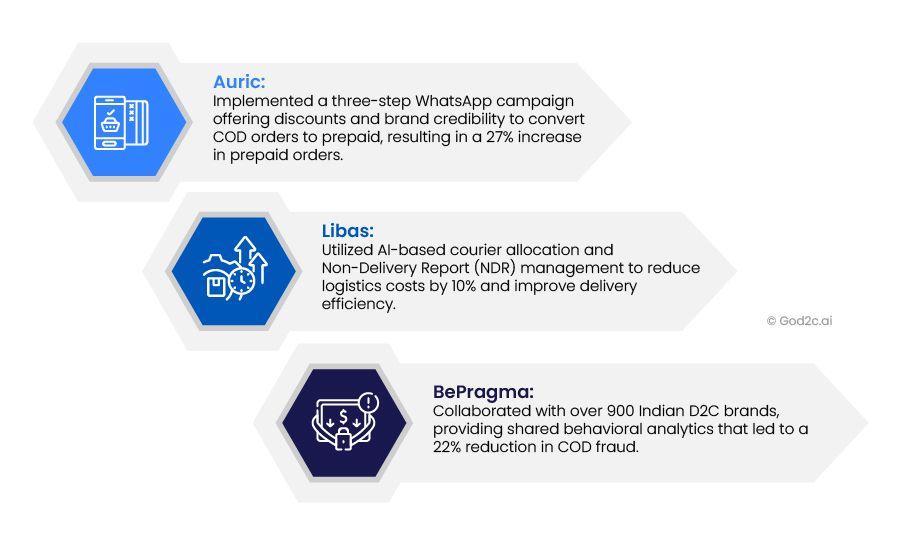How Conversational AI is Revolutionizing D2C Apparel Return Practices in India
In India's fast-changing apparel e-commerce sector, Cash on Delivery (COD) remains a popular payment method. The strong preference for COD among Indian consumers is the main reason behind high Return-to-Origin (RTO) rates. This isn't just a minor logistics issue but a fundamental threat to the long-term profits and sustainability of D2C brands. On average, the Indian e-commerce industry faces a 20-25% RTO rate, which can rise to a daunting 40% in the apparel category, depending on factors like location and product type.
Data shows that COD orders make up over 60% of total returns for more than two-thirds of all Direct-to-Consumer (D2C) brands, increasing operational costs and eating into margins.
Traditional strategies, like offering post-purchase discounts, often only treat the symptoms rather than addressing the main cause of high Return to Origin (RTO) rates. Without engaging customers before delivery, businesses miss the chance to confirm customer intent, leading to higher RTO rates.
This blog offers a detailed analysis of the RTO problem and presents a strategic, AI-powered solution designed to break this harmful cycle. The main idea is that conversational AI, when actively used across high-engagement channels like WhatsApp and through smart voice agents, can proactively verify customer intent, correct data errors, and handle delivery issues at scale. By shifting from a reactive to a proactive approach, brands can tackle the psychological and logistical root causes of RTO before the package leaves the warehouse or when a delivery problem first appears.
1. Deconstructing the COD Returns Spiral
1.1 The Silent Killer: Quantifying RTO
Return-to-Origin (RTO) occurs when a COD order fails to be delivered and is returned to the seller’s warehouse. Across India, average RTO rates range between 20–25%, but apparel stands out with 25–40%, making it a critical concern for D2C brands. For example, a brand processing 10,000 orders per month could see 2,500–4,000 orders returned, representing significant lost revenue.
RTO also varies regionally. Tier 3 and rural areas often experience 40–45% RTO, compared to 15–20% in Tier 1 cities (Delhivery study). A granular, data-driven strategy is essential, as a one-size-fits-all approach fails to address high-risk zones.
1.2 The True Cost: Beyond Shipping Fees
The financial impact of RTO goes beyond the lost sale. Each returned COD order incurs double logistics costs, warehouse handling, manpower, and potential inventory devaluation. For a mid-sized D2C brand shipping 10,000 COD orders per month with a 35% RTO, logistics alone can reach ₹7 lakh/month (~₹84 lakh/year).
Additionally, returned items lock up working capital and may lose relevance in fast-fashion markets, leading to markdowns or total loss. The financial impact is significant and represents a direct threat to long-term profitability.
1.3 Psychological & Operational Triggers
RTO is driven by both consumer behavior and operational gaps:
Consumer Behavior: COD builds trust, but the lack of upfront payment encourages impulse buying. Customers may place multiple orders to try before buying or cancel if they find a better deal. Rejecting orders at the doorstep is easy, lowering accountability.
Operational Gaps: Incorrect or incomplete addresses and carrier inefficiencies—delays or fake delivery attempts—also contribute to RTO.
A solution must move beyond discounts or post-delivery interventions. Brands need a pre-delivery strategy that validates intent, improves accountability, and manages the delivery journey proactively, transforming COD from a liability into a manageable, high-margin payment method.
How Can Conversational AI Break the Cycle
Traditional RTO management is reactive brandsattempt to mitigate losses only after a delivery fails. AI conversational commerce offers a proactive alternative: engaging customers at critical touchpoints throughout the order journey.
By confirming intent before shipping and immediately addressing delivery exceptions, brands can prevent costly RTOs while enhancing the customer experience. Customers move from uncertainty to a reassured, guided buying journey, improving both satisfaction and conversion rates.
AI addresses RTO through three core functions:
1. Intelligent Pre-Dispatch Verification
Automated chatbots and voice agents confirm COD orders immediately after they are placed. Simple messages—often via WhatsApp—allow customers to confirm or cancel with just a tap. This low-friction method helps filter out fake or impulsive orders, reducing RTO by 20–30% within a few weeks.
2. AI-Powered Risk Scoring & Address Validation
Advanced AI predicts the likelihood of RTO using historical order data, customer behavior, and address quality. Orders flagged as high-risk can undergo more rigorous verification, or COD may be temporarily turned off. Using aggregated data from multiple brands creates stronger predictive models that go beyond a single brand’s dataset.
3. Real-Time NDR Management
Even after dispatch, AI handles delivery issues. When a first attempt fails, automated Non-Delivery Reports (NDR) categorize problems, such as “customer unavailable,” “incorrect address,” or “delivery delayed.” Multi-channel notifications (WhatsApp, SMS, IVR) engage the customer to confirm availability and coordinate quick re-delivery. Platforms like ClickPost report that AI agents can resolve failed deliveries in under 2 minutes, cutting manual support by 75%.
The WhatsApp Advantage
WhatsApp is the most effective channel for conversational commerce in India, with over 880 million users. Its ubiquity ensures high engagement, while its conversational nature builds trust and intent confirmation.
Automated order confirmations, delivery updates, or live tracking notifications act as psychological trust signals, addressing the underlying causes of RTO. Brands leveraging WhatsApp-based engagement have reported up to 40% lower RTO rates and 1.7x higher prepaid conversion, demonstrating that a well-executed conversational strategy directly improves profitability.
Real Impact on Metrics
Implementing AI-driven pre-delivery conversations can lead to significant improvements:
- Reduction in RTO Rates: Brands have reported up to a 30% decrease in COD returns after integrating AI-based engagement strategies.
- Increase in Prepaid Transactions: AI nudges have led to a 15–20% increase in prepaid conversions, improving cash flow and reducing logistical burdens.
- Lower Reverse Logistics Costs: By decreasing failed deliveries, businesses save on return shipping and handling expenses.

Indian D2C Brands Leading the Way
Several Indian D2C brands have successfully leveraged AI-driven strategies to reduce COD returns:
- Auric: Implemented a three-step WhatsApp campaign offering discounts and brand credibility to convert COD orders to prepaid, resulting in a 27% increase in prepaid orders.
- Libas: Utilized AI-based courier allocation and Non-Delivery Report (NDR) management to reduce logistics costs by 10% and improve delivery efficiency.
- BePragma: Collaborated with over 900 Indian D2C brands, providing shared behavioral analytics that led to a 22% reduction in COD fraud.

Navigating Implementation & Charting the Future with GoD2C.ai
While conversational AI offers clear ROI in reducing COD returns and improving prepaid conversions, many brands hesitate due to perceived challenges in implementation. GoD2C.ai addresses these barriers head-on, making AI adoption effortless, secure, and scalable for D2C apparel brands.
1. Seamless Integration
GoD2C.ai integrates effortlessly with existing order management, CRM, and logistics systems. Brands do not need to overhaul their tech stack; the platform works with the systems already in place, enabling instant deployment without operational disruption.
2. Multi-Language NLP Expertise
India’s linguistic diversity can complicate AI communication. GoD2C.ai’s natural language processing engine is trained across multiple languages, dialects, and colloquial expressions, ensuring accurate intent recognition and human-like interactions across the country.
3. Data Privacy & Compliance
GoD2C.ai prioritizes data security with end-to-end encryption and stringent privacy protocols. All customer interactions are securely processed, and brands can transparently communicate how data is handled, building trust without compromising compliance.
4.Human-in-the-Loop Escalation
Even the best AI may encounter complex queries. GoD2C.ai provides a clear escalation path to human agents, ensuring customers always receive a resolution. This guarantees a seamless experience that enhances brand credibility rather than undermining it.
By removing these traditional barriers, GoD2C.ai empowers D2C apparel brands to adopt AI confidently, unlock operational efficiencies, and transform COD into a high-margin, low-risk payment option.
Conclusion: From Problem to Profitability
The COD Returns Spiral presents a vital challenge for Indian D2C apparel brands, driven by consumer behavior, operational inefficiencies, and financial pressures. It can’t be remedied solely with discounts or brief fixes; it demands a strategic, data-driven approach.
Conversational AI, when used effectively, is more than just automation—it’s a business strategy. By proactively verifying orders, forecasting RTO risk through pooled data, and managing delivery exceptions in real time, D2C brands can transform a major cost center into a source of trust, efficiency, and profit. Companies that have adopted these strategies see measurable drops in RTO, increased prepaid adoption, and better operational margins.
For D2C leaders, the path is straightforward: move from understanding the problem to executing a proven solution. GoD2C.ai offers the tools, insights, and AI-enhanced processes to make this shift smooth, removing traditional barriers and delivering real business value.
To discover how GoD2C.ai can improve your COD approach, lower returns, and increase margins, schedule a product demo and take the first step toward a profitable, future-ready D2C business.
References:
https://www.bepragma.ai/blogs/what-is-rto-charges
https://www.gokwik.co/blog/what-is-return-to-origin-rto-in-ecommerce
https://thebotmode.com/reduce-rto-in-ecommerce/
https://www.hexadesigns.in/blog/why-would-indian-e-commerce-stores-swear-by-cod-payments/
https://thebotmode.com/reduce-rto-for-d2c-brands/
http://yourstory.com/2025/08/tackling-product-returns-with-ai-how-d2c-brands-are-regaining-logistics
https://www.teneo.ai/blog/conversational-ai-implementation-6-challenges-solutions

